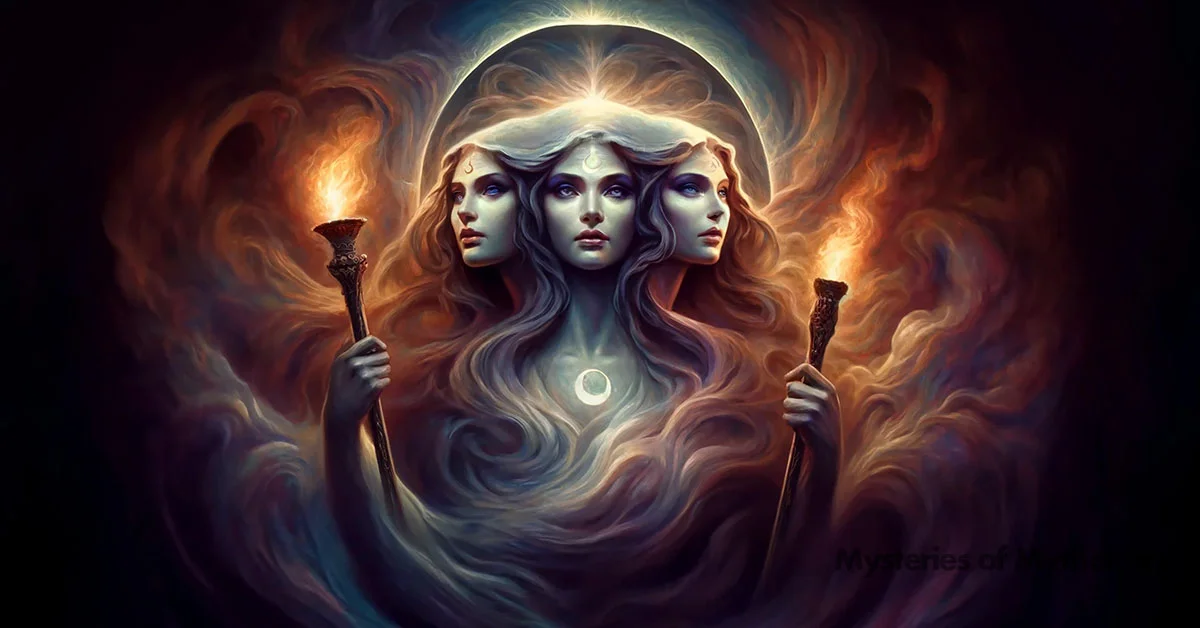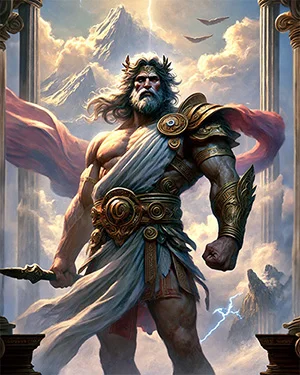Overview
Hecate is perhaps most well-known as the goddess of magic in Greek mythology. She is also associated with witchcraft, the night, the moon, ghosts, and necromancy. In the most popular version, her origins trace back to the Titans, the generation of gods before the Olympians, and was the only child of the Titans Perses and Asteria.
What’s unique about Hecate is that, unlike most other gods and goddesses, she isn’t associated with a single domain.
Hecate’s domain stretched across the Earth, the sea, and the sky. She is often depicted as a triple-formed deity with either three heads or three bodies, symbolising her power over earth, sea, and sky, or, some say, over the past, present and future. She is commonly shown holding torches and keys and accompanied by dogs, all linked to her different powers and roles, which I’ll discuss later.
As depicted in ancient texts, Hecate is a protector and guide known for her ability to cross the boundaries between the mortal and divine worlds. Her worship was widespread, with rituals often performed at crossroads, which were considered sacred to her.
Today, Hecate’s influence is also seen in modern paganism and witchcraft, where she continues to be a prominent figure symbolising mystery, protection, and transformation. Perhaps the reason why Hecate is so different from other gods is that many think that her origins came from a time far earlier than when Greece was formed.
Want to know more? Read on…
Watch the related video
Etymology
The name “Hecate” comes from the Greek name Ἑκάτη (Hekátē), which translates to “Worker from Afar” or “The One Who Works Her Will.” This name shows her strong and widespread influence across various domains in both the mortal and divine realms. The Latin spelling of her name is Hecate or Hecata, which remains widely recognised in modern references to the goddess.
Pronunciation
ENGLISH
Hecate
GREEK
Ἑκάτη
PHONETIC
Heh-KAH-tee
IPA
/ˈhɛk.ə.ti/
Alternative names
In various texts, you may come across different spellings like Hekate, Hekata, or Hecata, all referring to the same goddess. The Romans knew her as Trivia, meaning “she of the triple road,” which connected her to her connection with crossroads.
Epithets
Hecate is known by several names that show her different roles and areas of influence.
- Chthoniē (Chthonic): This term signifies her role as an underworld goddess. It reflects her association with the earth and the dead, often depicted in ancient texts as a formidable deity ruling over the souls of the departed and purifications.
- Nyktypolos (She who wanders at night): This epithet emphasises her connection to the night and witchcraft. Hecate is often associated with nocturnal rituals and magic.
- Skylakagetis (Leader of dogs): Dogs are sacred to Hecate, symbolising her role as a guide and protector, especially in her chthonic and underworld aspects. They are often depicted as her companions in various iconographies.
- Trioditis (She of the triple road) and Enodia (She of the road): Both epithets connect Hecate to crossroads, which are significant in her worship. Crossroads were considered places of power where offerings were left for her. The Romans adopted this aspect, referring to her as Trivia.
- Sōteira (Savior): This title reflects Hecate’s protective nature. In later traditions, she was regarded as a universal saviour and even associated with cosmic order and protection.
- Atalos (Tender) and Kourotrophos (Nurse of the young): These epithets highlight her nurturing aspects. Hecate was considered a protector of children and was invoked for the care and safety of the young.
- Phōsphoros (Bringer of light): Often depicted with torches, Hecate was seen as a guide through the darkness, symbolising light and enlightenment. This aspect ties her to the moon and its phases, further cementing her role in magic and witchcraft.
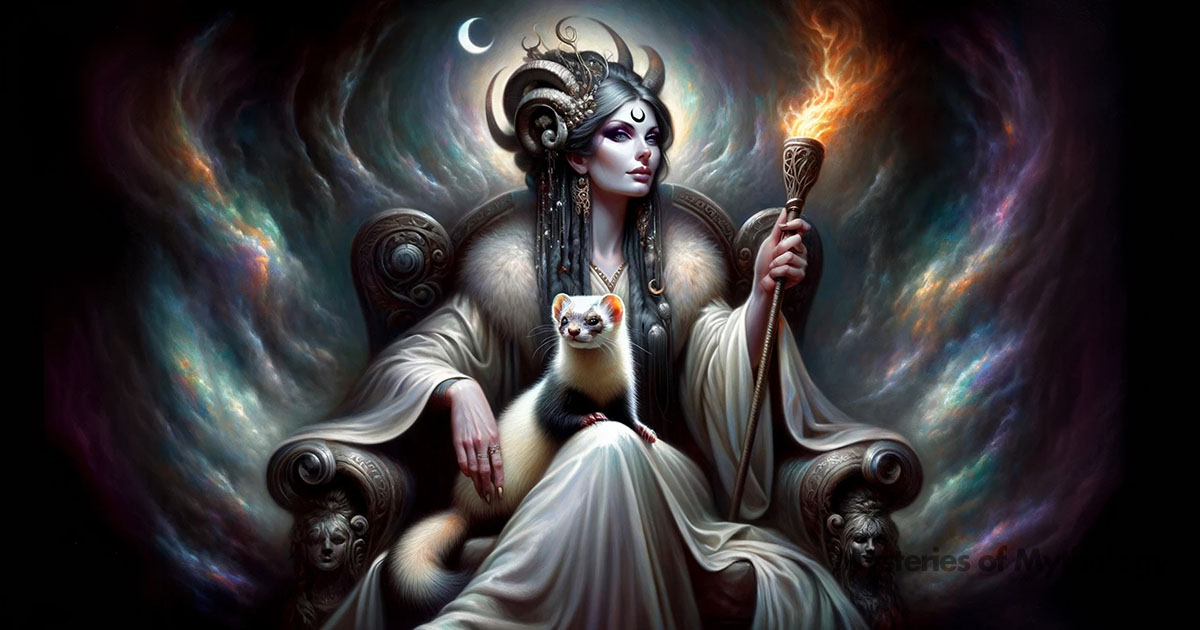
Attributes
Origins
Hecate’s origins are somewhat mysterious and debated among scholars. Unlike many Olympian deities, Hecate’s roots lie in the older, pre-Olympian layers of Greek religion. She was likely a Carian goddess adopted by the Greeks during the Archaic Period (ca. 800–480 BCE).
The description and appearance of Hecate changed significantly over time. The poet Homer, who is normally attributed as a source for Greek mythology, never spoke of her. She first appeared in Hesiod’s Theogony in the seventh century BCE, where she appeared very different from the underworld goddess that we know today.
Depending on the source, there are varying accounts of Hecate’s parentage. The most common description names her as the daughter of the Titans Perses, the titan of destruction, and Asteria, the Titan goddess of falling stars and nocturnal divination, such as astrology.
However, other sources provide alternative lineages. Musaeus, a scholar of Athens, claimed that she was the daughter of Asteria and Zeus. The lyric poet Bacchylides suggests she emerged from the night itself or the primordial goddess Nyx, presenting her as a primordial deity. Euripides presents her as the daughter of Leto, Apollo’s mother, and in Sicilian legend, she is said to be the offspring of Admetus and a Pheraean woman.
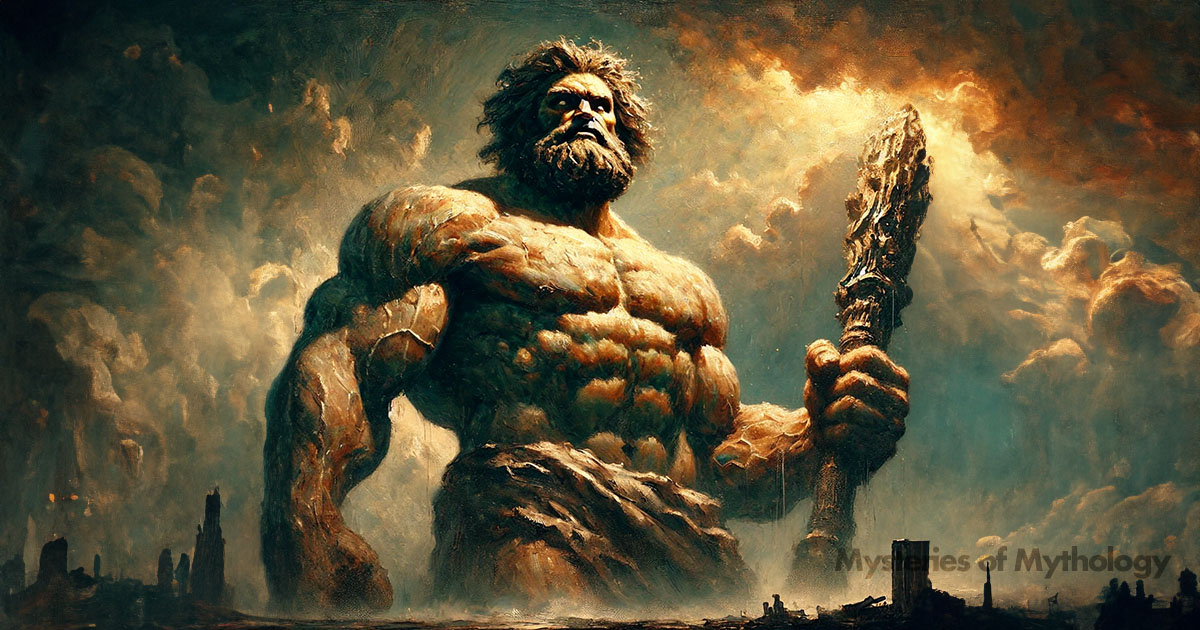
Hecate’s connection to Thracian divinity is particularly interesting. The Thracians were an ancient group of tribes who lived in parts of what are now Bulgaria, Greece, and Turkey. They had their own gods and goddesses, which were thought to have influenced Greek and Anatolian cultures.
During the Titanomachy—the great war in which the Olympian gods overthrew the Titans—Hecate sided with the Olympians. It was said that Zeus uniquely honoured her. He granted her dominion over heaven, earth, and sea. Although most argue, she didn’t need Zeus’s blessing. This extensive power meant that, depending on her judgment, Hecate could choose to bestow or withhold wealth, victory, wisdom, good fortune, and prosperity from mortals.
By the fifth century BCE, Hecate was primarily known as the goddess of magic and witchcraft. She was also linked to the Underworld, ghosts, the moon, various animals (especially dogs and creatures of the night), female initiation (including marriage and childbirth), agriculture, and entrances to both public and private spaces, such as crossroads, doorways, and fortifications.
Icons and Symbols of Hecate
In early art, Hecate appeared like other goddesses, modestly robed and often seated. Around 430 BCE, she began to be depicted in her distinctive triplicate form, with either three faces or three women, representing her role as the goddess of crossroads. This triplicate form allowed her to watch over multiple roads simultaneously.
Statues of the triple-Hecate, called hecataea (singular hecataeon), became popular and were often placed at crossroads or in front of homes. Other common symbols included the polos (a cylindrical crown), torches (symbolising her guidance through the darkness), and keys (representing her power over transitions and thresholds).
Hecate was frequently accompanied by dogs, whose barking was said to herald her approach at night, often with the souls of the dead, especially the souls of girls who had died unmarried or childless, in tow.
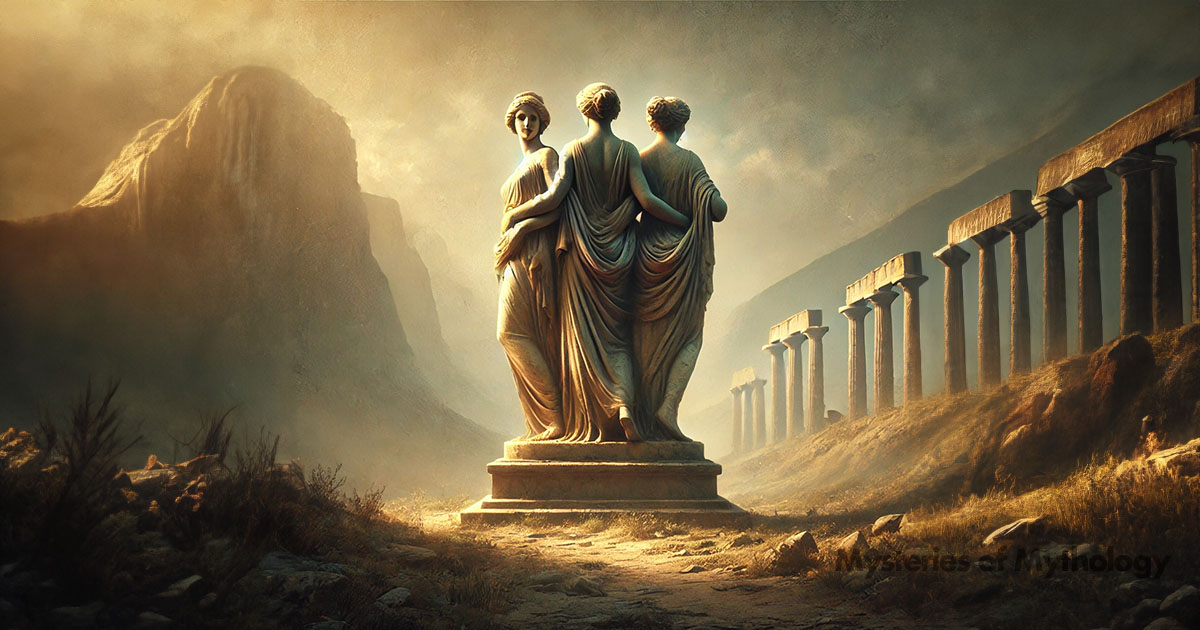
Hecate’s other symbols included swords, snakes, polecats, red mullets, boughs, flowers, and pomegranates. She was sometimes depicted as the guardian of the gates of the Underworld or the keeper of its keys. Unique depictions showed her with frightening features, such as having man-eating dogs for feet or three heads of different animals (a horse, a dog, and a lion). One vase even shows Hecate with the Erinyes, or Fates, and by late antiquity, the Orphics (a religion originating from Thrace) sometimes imagined her with three heads of a horse, a dog, and a lion.
Hecate’s triple form is thought to symbolise her power over earth, sea, and sky, or the past, present, and future. She is shown holding twin torches, representing her role as a guide through the darkness and keys, signifying her control over thresholds and transitions between worlds. She is frequently accompanied by black she-dogs, which are sacred to her and symbolise her role as a guardian and protector. Crossroads are a common theme in her depictions, highlighting her connection to transitions and choices.
Sacred Animals and Plants
Hecate’s sacred animals include the black she-dog (Hekabe) and the polecat (Gale or Galinthias). According to one myth, Hecate transformed a woman named Gale into a polecat as punishment for her inappropriate behaviour.
Another version involves Galinthias, the friend and midwife of Alcmene, the mother of Heracles. When Hera attempted to prevent Heracles’ birth, Galinthias tricked the gods, and as a punishment, she was turned into a polecat. Hecate, moved by Galinthias’s loyalty and cleverness, made her one of her sacred animals.
Snakes are commonly associated with Hecate, symbolizing rebirth, regeneration, and the underworld. Their shedding of skin is seen as a form of regeneration, resonating with Hecate’s role in transitions and transformative events.
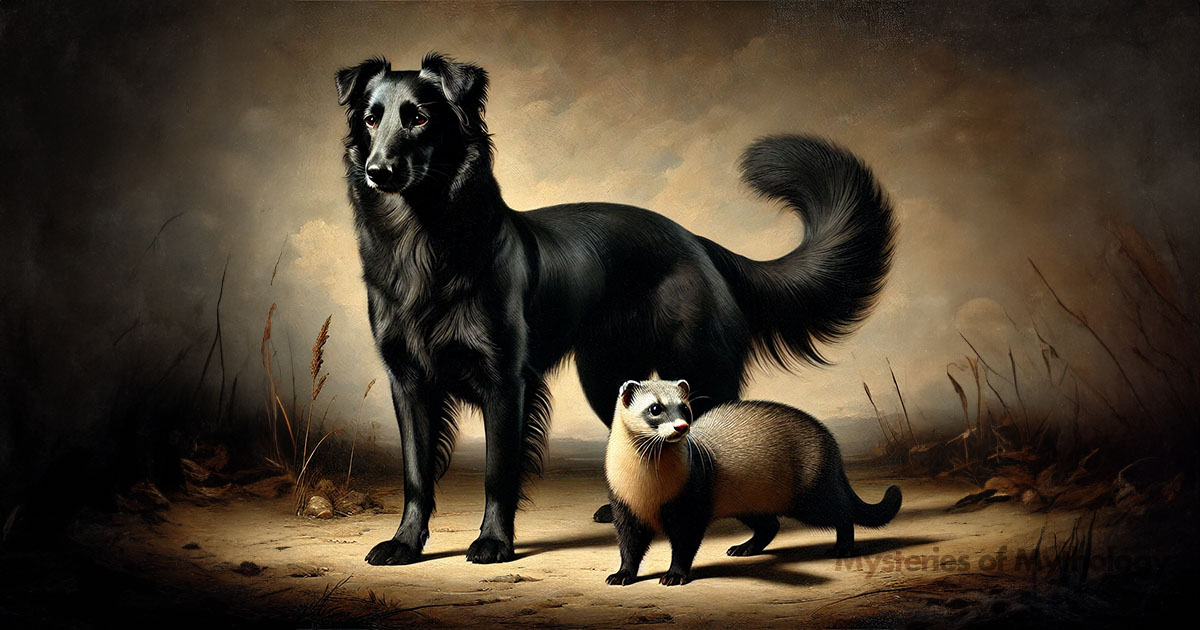
Family
Hecate’s lineage is rooted in the Titans, making her part of an ancient and powerful lineage. Her parentage and offspring highlight her connections to both the primordial forces and significant mythological figures.
Hecate’s family connections are complex, and vary in different mythological accounts. Her parents, Perses and Asteria, align her with the Titans, while alternative accounts link her to Zeus or Nyx, the primordial goddess of night. Despite being a virgin goddess, she is sometimes associated with figures like Scylla, Circe, and Medea.
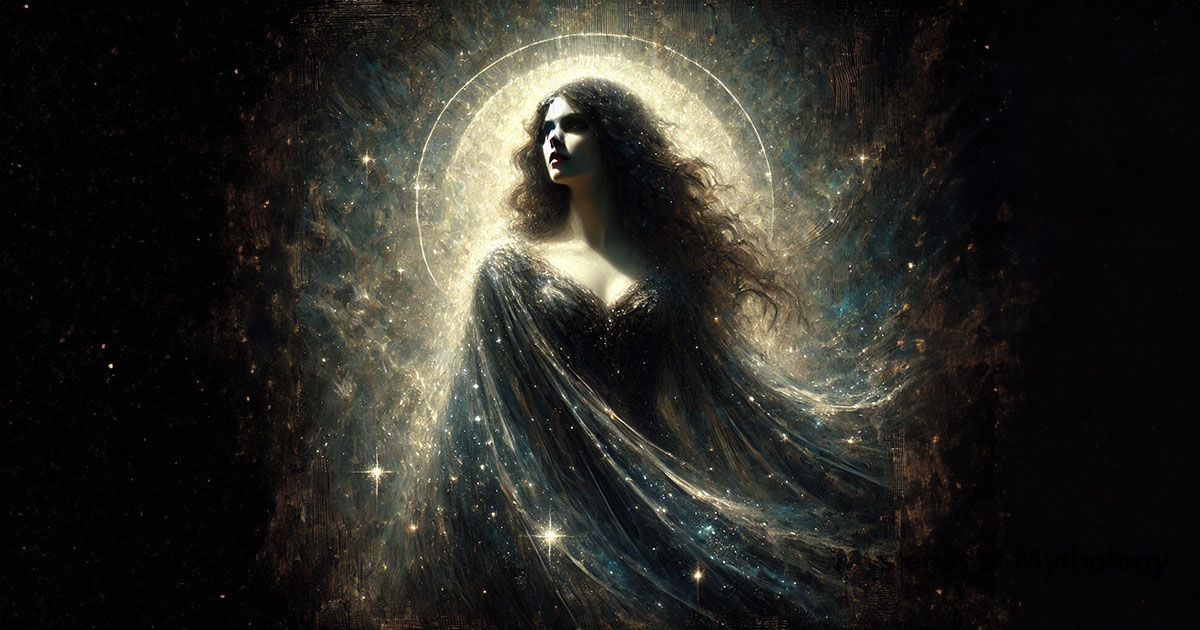
Family Tree
Parents
Father
Perses, Zeus
Mother
Asteria, Nyx
Children
None
Hecate is often considered a virgin goddess
Daughters
Scylla, Circe, Medea
Mythology
Zeus’s Birth
Hecate appears in some versions of the myth about the birth of Zeus. This story tells of how the Titan Cronus swallowed each of his children as soon as they were born, fearing they would overthrow him. When his last child, Zeus, was born, Cronus’ wife, Rhea, decided to save the newborn’s life. She wrapped a stone in swaddling clothes for Cronus to swallow while she hid the real Zeus away.
In most versions of the myth, Rhea is the one who brings Cronus the stone. However, one unique version depicted on the eastern frieze of the Temple of Hecate at Lagina, shows Rhea sending Hecate to give Cronus the stone instead.
Gigantomachy
In the mythological battle known as the Gigantomachy, the Olympian gods fought against the Giants, the monstrous offspring of the earth goddess Gaia. This epic conflict was triggered by Gaia’s desire to overthrow the Olympian gods in retaliation for the imprisonment of her Titan children. The Giants, born from Gaia and the blood of Uranus, were immensely powerful and posed a significant threat to the Olympian gods.
Hecate, known for her magic and formidable strength, sided with the Olympians during this battle. She used her torches as weapons, which were symbolic of her ability to illuminate and reveal hidden dangers. With her torches, she fought fiercely and ultimately defeated the Giant Clytius, who had been specifically created to be immune to fire and light, making Hecate’s victory even more impressive.
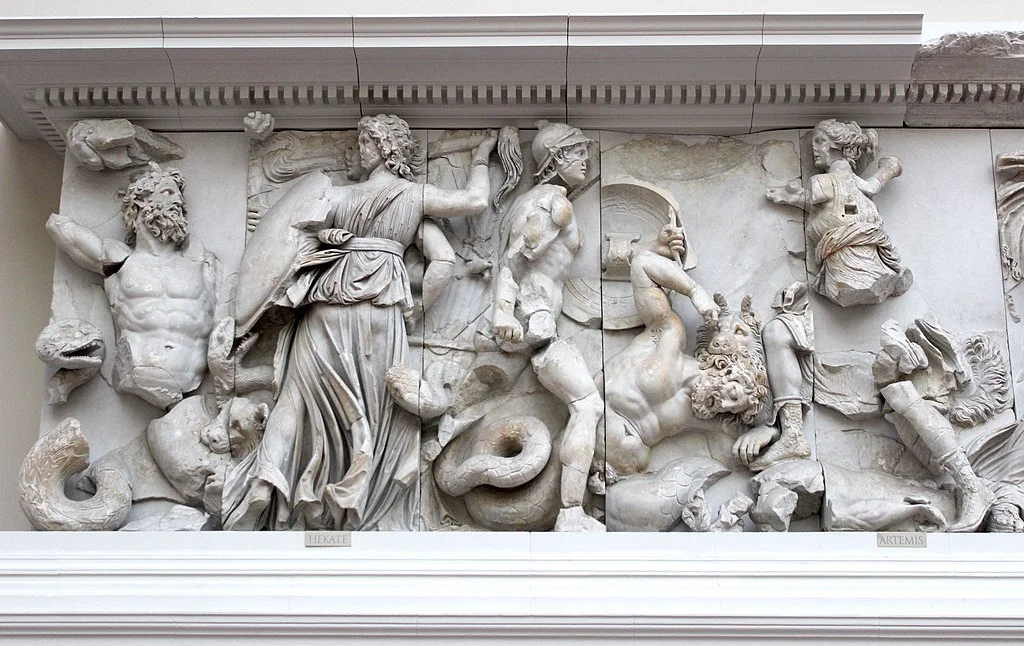
This dramatic scene of Hecate battling Clytius was frequently depicted in ancient art, showcasing her as a powerful and vital ally of the Olympian gods. Such representations can be found on the western frieze of Hecate’s temple in Lagina and the famous Gigantomachy frieze of the Pergamon Altar.
The Abduction of Persephone
Hecate is also found in the myth of Persephone’s abduction, a central story in Greek mythology. This myth tells how Persephone, the daughter of Demeter, the goddess of the harvest, was abducted by Hades, the god of the Underworld, to be his queen. When Persephone was taken, Hecate was the only one who heard Persephone’s cries for help.
As Demeter wandered the earth in despair, searching for her missing daughter, Hecate approached her and revealed what she had heard. Though she did not know where Persephone had been taken, Hecate advised Demeter to seek out Helios, the sun god, who sees everything that happens during the day. Helios confirmed that Hades had taken Persephone to the Underworld.
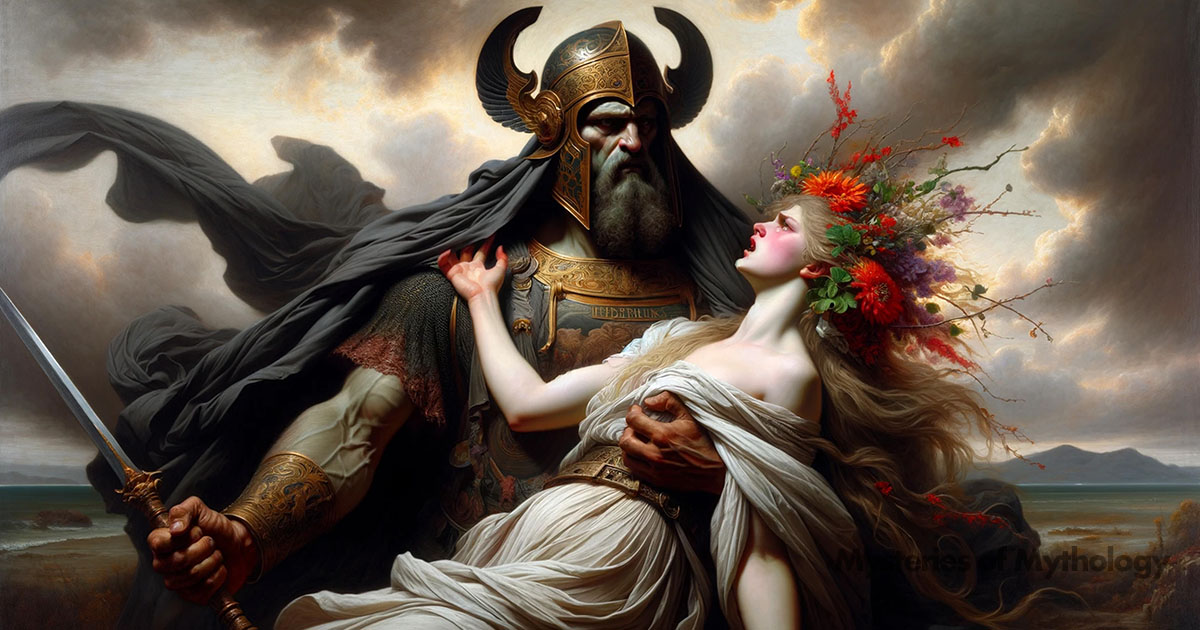
Zeus eventually intervened and ordered Hades to return Persephone to her mother. However, because Persephone had eaten pomegranate seeds in the Underworld, she was bound to spend part of each year there. This compromise led to the cyclical change of seasons: Persephone’s return to the surface heralded spring and summer, while her return to the Underworld marked autumn and winter.
Hecate’s involvement in the search for Persephone earned her a place of honour in the Eleusinian Mysteries, a set of religious rites held in Demeter and Persephone’s honour, and became Persephone’s attendant and received great respect in the cult of Demeter and Persephone.
Hecate and the Polecat
There are two primary versions of how the polecat became associated with Hecate, each highlighting different aspects of Hecate’s character and compassion.
In one version, the tale is set at the birth of the hero Heracles. Hera, the jealous wife of Zeus, attempted to prevent Heracles’ birth by sending Eileithyia, the goddess of childbirth, and the Moirae, the Fates, to hold Alcmene’s womb shut. Alcmene’s loyal handmaid, Galinthias, tricked the goddesses by falsely announcing that the child had already been born. Caught off guard, Eileithyia and the Moirae released their hold, allowing Heracles and his twin, Iphiclies, to be born.
As punishment for her deception, Galinthias was transformed into a polecat. Hecate, taking pity on her, made Galinthias her sacred attendant, thus linking the polecat to Hecate’s domain.
In another version, the polecat was once a witch named Gale. Gale was so perverse in her sexual behaviour that the gods punished her by turning her into a polecat. In this form, she was condemned to serve Hecate.
Patron Goddess of Witches
Hecate is known as the patron goddess of witches in Greek and Roman mythology. She is revered for her mastery of magic and her control over the spaces that exist between the worlds of the living and the dead. Witches and sorcerers often invoke her in various myths and stories for her powerful abilities.
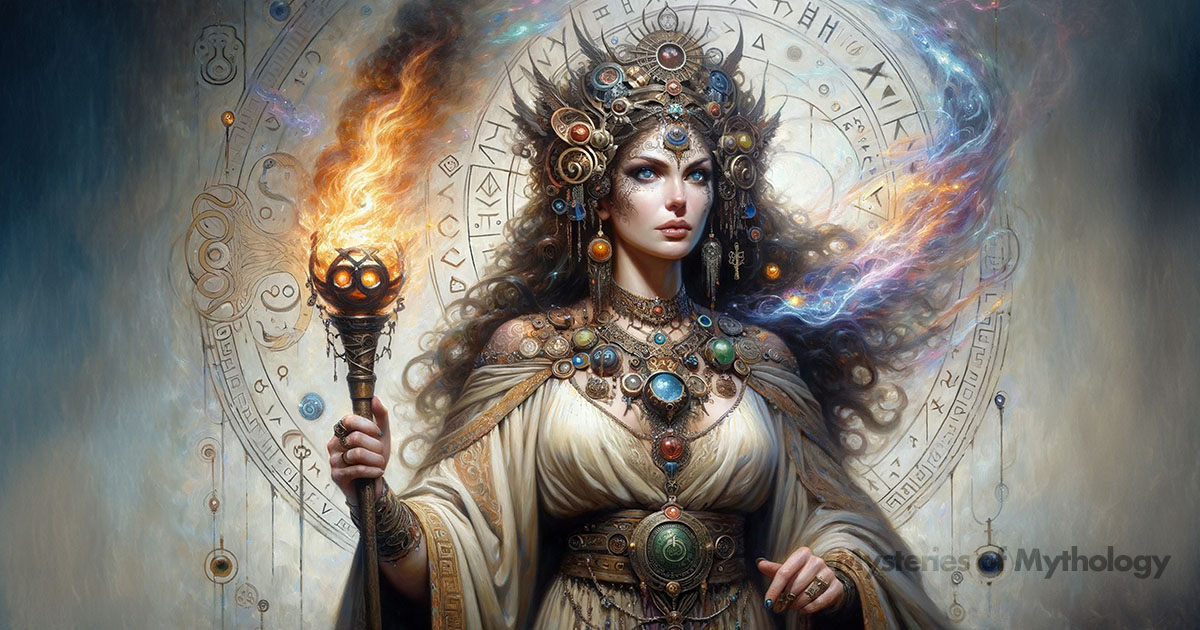
Medea, the famous sorceress who aided Jason and the Argonauts in their search for the Golden Fleece, is one of the most well-known followers of Hecate. Her story, characterized by her dramatic and often dark practice of magic, emphasizes Hecate’s connection with powerful and transformative spells.
One other important character is Simaetha, who appears in a poem by the Hellenistic poet Theocritus. In the poem, Simaetha asks Hecate to bring back her lover, Delphis, using spells and incantations that show Hecate’s involvement in love and revenge. This invocation demonstrates how women, might turn to Hecate for help in their personal and emotional struggles through magical practices.
The Roman poet Horace also features Hecate in his works, particularly in the character of Canidia, a witch who performs dark rites and invokes Hecate in her spells. Canidia’s association with grave desecration, kidnapping, murder, poisoning, and torture reflects the darker aspects of Hecate’s worship and her feared power over life and death.
Hecate’s role as the patron goddess of witches is further emphasised by her symbols and sacred animals, such as the black she-dog and the polecat, which were often associated with witchcraft and the supernatural. Her presence at crossroads, a place traditionally linked with magic and supernatural encounters, also reinforces her connection to witchcraft. Crossroads were believed to be sites where the boundaries between worlds were thin, making them ideal for performing magical rituals and invoking Hecate’s aid.
Throughout Greek and Roman literature, Hecate’s portrayal as a goddess of magic, witchcraft, and the night reflects her enduring legacy as a powerful and enigmatic figure, invoked by those seeking to harness the supernatural forces she governs.
Worship
Ancient Practices
Central to Hecate’s worship were the practices known as “Hecate’s Suppers” or the Deipnon, which took place during the dark moon phase of the lunar cycle. On these nights, devotees would leave offerings at crossroads to honour Hecate and appease the restless spirits and ghosts that wandered the earth. These offerings typically included food—often eggs, fish, and garlic—but the key aspect was that once placed, they were not to be looked back upon after leaving, symbolising a complete offering to Hecate and the spirits.
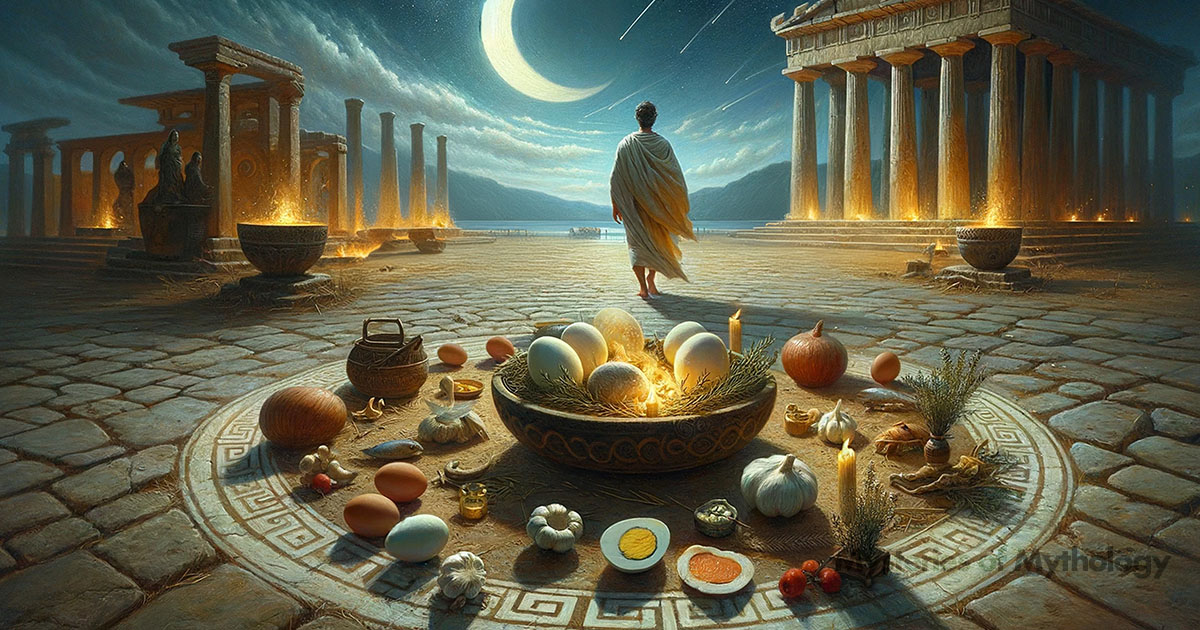
The choice of crossroads for these offerings emphasizes Hecate’s role as the goddess of boundaries and transitions. Crossroads symbolize points of decision and potential change, reflecting Hecate’s power over transformation and her ability to see into the past, present, and future.
Modern Practices
Hecate continues to be a prominent figure in Neo-pagan and Wiccan traditions. Practitioners often invoke her during rituals involving magic, protection, and guidance. Offerings and ceremonies are performed, sometimes mirroring ancient practices but adapted to contemporary spiritual contexts.
Modern devotees might create altars adorned with symbols of Hecate, such as keys, torches, and images of dogs. Offerings can include food, drinks, and incense, and rituals often incorporate candle lighting and chanting to invoke her presence and power.
Celebrations and Festivals
One of the key rituals dedicated to Hecate is the Deipnon, which occurs on the night before the new moon. During this time, offerings are made to purify the home and seek Hecate’s protection. The Deipnon involves cleaning the house, leaving offerings at crossroads, and performing rituals to honour Hecate. These practices are intended to cleanse and protect the household, creating a fresh start for the new lunar month.
Other modern practices might include seasonal celebrations and personal rituals to honour Hecate’s role as a goddess of transitions and magic. Practitioners often celebrate her during the dark moon phase, using this time for introspection, divination, and setting intentions for new beginnings.
Cult Centers
Hecate was worshipped at several significant locations in ancient Greece. Major cult centres included Caria, Eleusis, and Samothrace. In Caria, Hecate was particularly revered and had a grand temple at Lagina, where elaborate festivals and processions took place in her honour.
At Eleusis, she played a key role in the Eleusinian Mysteries, which were some of the most important religious rites in ancient Greece. Samothrace was another important centre where she was worshipped alongside other deities in the mystery cults.
Pop Culture
Hecate in Literature and Art
Ancient statues and reliefs frequently depict Hecate holding torches and keys, symbolising her role as a guide and protector. Her triple form is also a common motif, representing her dominion over earth, sea, and sky. These depictions emphasise her power and her multifaceted nature, capable of seeing in all directions and influencing various aspects of life and the supernatural.
Hecate in Classical Literature
Classical literature often references Hecate, with notable mentions in texts such as Hesiod’s “Theogony” and the “Homeric Hymn to Demeter.” These works highlight her significant role in Greek mythology and her interactions with other deities and mortals. She is depicted as a powerful and influential goddess, respected and sometimes feared for her control over magic and the underworld.
Hecate in Modern Media
Hecate has appeared in numerous modern works of fiction, often portrayed as a powerful and mysterious figure associated with magic and the supernatural. For example, she is prominently featured in the “Percy Jackson & The Olympians” series by Rick Riordan, where she is depicted as a formidable goddess of magic. Her role in these stories often blends her ancient attributes with modern interpretations, casting her as a guardian of magical realms and a powerful force to be reckoned with.
Hecate has made numerous appearances in modern media, including TV shows and movies. In Shakespeare’s “Macbeth,” she oversees the witches and embodies themes of chaos and fate. She is also featured in the TV series “Charmed” as a powerful demon queen and in “American Horror Story: Coven” as a figure invoked for her dark magical prowess. These portrayals often emphasise her enigmatic and powerful nature, making her a compelling character in narratives involving magic and the supernatural.
Hecate’s influence extends into music and visual art, where she is sometimes referenced in song lyrics, album artwork, and various artistic expressions. Artists like Kate Bush and Florence + The Machine have drawn inspiration from her mythos, incorporating themes of mystery and transformation into their works.
Frequently Asked Questions
Who were Hecate’s parents?
Hecate’s parents are the Titans Perses and Asteria. In some variations of her myth, Zeus and Asteria or Nyx are mentioned as her parents.
What symbols are associated with Hecate?
Hecate is associated with twin torches, keys, black she-dogs, polecats, and plants like yew and cypress. She is often depicted in a triple form, symbolising her dominion over earth, sea, and sky.
How is Hecate worshipped today?
Today, Hecate is worshipped in Neo-pagan and Wiccan practices through rituals, offerings, and invocations. Celebrations often include rituals at crossroads and offerings during the dark moon.
What is the significance of Hecate at crossroads?
Crossroads are significant to Hecate as they symbolise transitions and boundaries. Hecate is believed to guard these liminal spaces, offering protection and guidance to travellers and those at metaphorical crossroads in life.
How does Hecate appear in mythology?
In various myths, Hecate is a powerful goddess of magic and witchcraft. She aids Demeter in the search for Persephone and assists heroes like Medea and Jason. Her roles include protector and guide between realms.
What are some modern representations of Hecate?
Modern representations of Hecate include appearances in literature, movies, and TV shows. She is featured in works like Shakespeare’s “Macbeth” and contemporary fantasy novels, often depicted as a powerful and mysterious figure embodying themes of magic and the supernatural.
References
- Hesiod, Theogony – Greek Epic C8th – 7th B.C.
- The Homeric Hymns – Greek Epic C8th-4th B.C.
- Euripides, Medea – Greek Tragedy C5th B.C.
- Aristophanes, Wasps – Greek Comedy C5th – 4th B.C.
- Aristophanes, Plutus – Greek Comedy C5th – 4th B.C.
- The Orphic Hymns – Greek Hymns C3rd B.C. – C2nd A.D.
- Apollonius Rhodius, The Argonautica – Greek Epic C3rd B.C.
- Theocritus, Idylls – Greek Poetry C3rd B.C.
- Diodorus Siculus, The Library of History – Greek History C1st B.C.
- Strabo, Geography – Greek Geography C1st B.C. – C1st A.D.
- Pausanias, Description of Greece – Greek Travelogue C2nd A.D.
- Apollodorus, The Library – Greek Mythography C2nd A.D.
- Magic Papyri – Greek Spells and Formulas C1st B.C. – 4th A.D.
- Aelian, On Animals – Greek Natural History C2nd – 3rd A.D.
- Antoninus Liberalis, Metamorphoses – Greek Mythography C2nd – 3rd A.D.
- Chaldean Oracles – Greek Mystical Texts C3rd – 6th A.D.
- Nonnus, Dionysiaca – Greek Epic C5th A.D.

